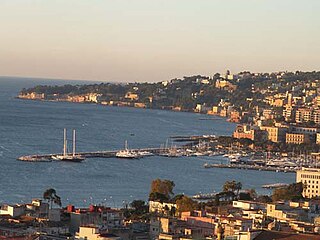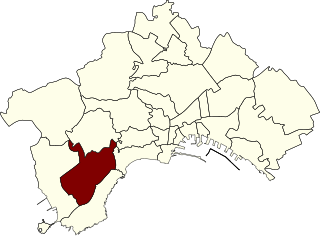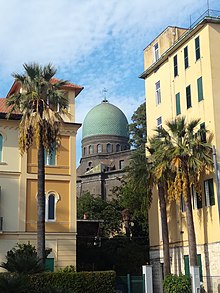
The Mausoleum of Theodoric is an ancient monument just outside Ravenna, Italy. It was built in 520 AD by Theodoric the Great, king of the Ostrogoths, as his future tomb.

A mausoleum is an external free-standing building constructed as a monument enclosing the interment space or burial chamber of a deceased person or people. A mausoleum without the person's remains is called a cenotaph. A mausoleum may be considered a type of tomb, or the tomb may be considered to be within the mausoleum.

The Ming tombs are a collection of mausoleums built by the emperors of the Ming dynasty of China. The first Ming emperor's tomb is located near his capital Nanjing. However, the majority of the Ming tombs are located in a cluster near Beijing and collectively known as the Thirteen Tombs of the Ming dynasty. They are located within the suburban Changping District of Beijing Municipality, 42 kilometers (26 mi) north-northwest of Beijing's city center. The site, on the southern slope of Tianshou Mountain, was chosen based on the principles of feng shui by the third Ming emperor, the Yongle Emperor. After the construction of the Imperial Palace in 1420, the Yongle Emperor selected his burial site and created his own mausoleum. The subsequent emperors placed their tombs in the same valley.

Bayburt Province is a province of Turkey. Located in the Northeast Anatolia region of the country, the capital city is Bayburt, and with a population of 74,412 is the least-populous province in Turkey.

The Mausoleum of Augustus is a large tomb built by the Roman Emperor Augustus in 28 BC on the Campus Martius in Rome, Italy. The mausoleum is located on the Piazza Augusto Imperatore, near the corner with Via di Ripetta as it runs along the Tiber. The grounds cover an area equivalent to a few city blocks nestled between the church of San Carlo al Corso and the Museum of the Ara Pacis. The mausoleum has been restored and reopened to the public in March 2021, after fourteen years of closure.

Mergellina is a coastal district of the city of Naples, Italy. It is located in the quartiere of Chiaia. It stands at the foot of the Posillipo Hill and faces the Castel dell'Ovo. Some people say the name derives from "mergoglino", a local name for the smew, others believe it is a corruption of "Mare Giallo", which refers to when the sea turned yellow due to floating tufa rock dust following a volcanic eruption many centuries ago. However, very likely the real origin of the name is from Latin "mare ialinum", that stands for clear, transparent sea.

Posillipo is an affluent residential quarter of Naples, southern Italy, located along the northern coast of the Gulf of Naples.
Laguna de las Momias, also known as Laguna de los Cóndores is an archaeological site located in Leimebamba, in the province of Chachapoyas in the Amazonas Region of Peru, excavated by the archaeologist Federico Kauffmann Doig. The site is called "Laguna de los Condores" because the people that found the lagoon would see these birds soar near the lagoon and it also obtained the name " Laguna de las Momias" because of the findings of the mummies around the area. The Chachapoyas were an old civilization that was located in the northern forest in the time of 900 a.c. This culture had been unknown by archaeologist for hundreds of years until the mummies appeared.

Fuorigrotta is a western suburb of Naples, southern Italy. Covering an area of 6,2 km2, it is the most populated suburb of the city.

Giovanni Battista Amendola (1848–1887) was an Italian sculptor from Sarno.

Parco Virgiliano is a scenic park located on the hill of Posillipo, Naples, Italy. The Park serves as a green oasis, built on the tufa stone typical to the coast of Posillipo.
Juan Arévalo was an Assembly Member of the Declaration of Philippine Independence, which was proclaimed in 1898. He was the son of Bonifacio Flores Arévalo and Trinidad Arévalo. His remains are buried with other Assembly Members of the Declaration of Philippine Independence, at the Mausoleo de los Veteranos de la Revolución in Manila North Cemetery.

The Mausoleum of Helena is an ancient building in Rome, Italy, located on the Via Casilina, corresponding to the 3rd mile of the ancient Via Labicana. It was built by the Roman emperor Constantine I between 326 and 330, originally as a tomb for himself, but later assigned to his mother, Helena, who died in 330.

The Mausoleum of the Atilii is a Roman mausoleum dating from 2nd or 3rd centuries AD, located in the municipal territory of Sádaba, Aragon, eastern Spain.
The Serie A1 di pallanuoto maschile is the premier division of the Italian water polo male national championship. First held in 1912, it is currently contested by twelve teams. Pro Recco is Serie A1's most successful club with 32 titles since 1959, followed by CN Posillipo with eleven.

San Strato a Posillipo is a parish church in the Posillipo neighborhood of Naples, Italy.
The Mausoleo dei 40 Martiri is a modern memorial chapel and garden located in Gubbio, region of Umbria, Italy, built in memory of Italians massacred by retreating German troops in 1944.

Villa Rocca Matilde is a 19th-century seaside villa, located on Via Posillipo #222, below Piazza San Luigi, in the neighborhood of Posillipo, Naples, Italy.
List of people with surname Schilizzi:
















